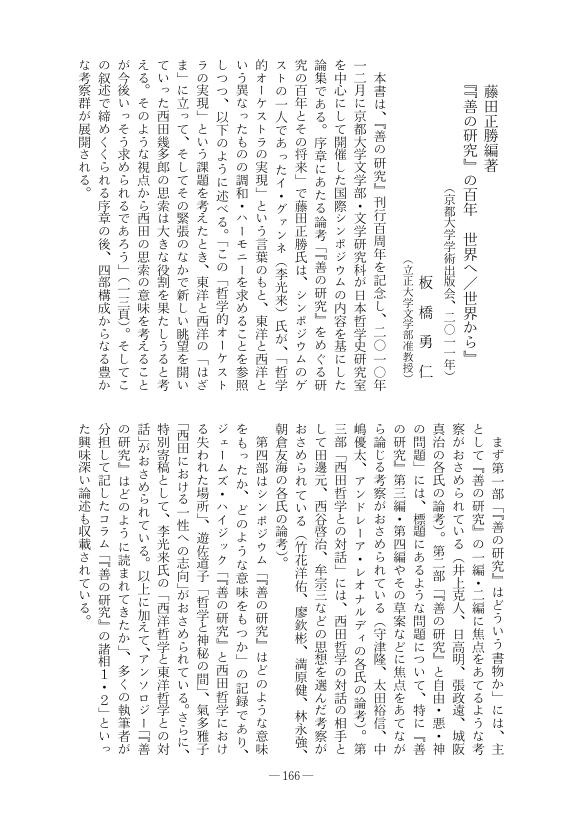3 0 0 0 OA ウィトゲンシュタインとショーペンハウアー 底無き意志の倫理をめぐって
- 著者
- 板橋 勇仁
- 出版者
- 日本哲学会
- 雑誌
- 哲学 (ISSN:03873358)
- 巻号頁・発行日
- vol.2022, no.73, pp.52-65, 2022-04-01 (Released:2022-07-21)
- 参考文献数
- 8
2 0 0 0 OA ヘーゲル世界史哲学にオリエント世界像を結ばせた文化接触資料とその世界像の反歴史性
- 著者
- 神山 伸弘 石川 伊織 板橋 勇仁 栗原 裕次 柴田 隆行 田中 智彦 東長 靖 橋本 敬司 早瀬 明 久間 泰賢 権左 武志
- 出版者
- 跡見学園女子大学
- 雑誌
- 基盤研究(B)
- 巻号頁・発行日
- 2009
ヘーゲルの世界史哲学講義(1822/23)については、本邦では、その世界像を結ぶための文化接触資料が必ずしも明確でなく、そのオリエント論に対する評価も低い。この事情を批判しながら、本邦ではじめてその資料源泉を探求しつつ本講義を翻訳し訳註を付するなかで、ヘーゲルのオリエント世界像は、ヨーロッパに映った近代オリエント世界像として反歴史的な空間的併存を示すとともに、ヨーロッパ的普遍史を脱却する歴史的理解も示しており、これらを通じて-ロマン派批判も込められたかたちでの-オリエントとヨーロッパの相互承認関係を展望していることが明らかになった。
1 0 0 0 OA 書評 藤田正勝編著 『『善の研究』の百年 世界へ/世界から』
- 著者
- 板橋 勇仁
- 出版者
- 西田哲学会
- 雑誌
- 西田哲学会年報 (ISSN:21881995)
- 巻号頁・発行日
- vol.10, pp.166-171, 2013 (Released:2020-03-22)
1 0 0 0 OA 歴史的世界の個性的な自己創造と国家 西田哲学における「国家」と「民族」
- 著者
- 板橋 勇仁
- 出版者
- 西田哲学会
- 雑誌
- 西田哲学会年報 (ISSN:21881995)
- 巻号頁・発行日
- vol.7, pp.55-76, 2010 (Released:2020-03-23)
The idea of the state, in Nishida’s latter thought, cannot be analyzed without viewing the big change in his idea of ethnic people. By this change, Nishida considers the state is the community, which can be possible by denying thoroughly our desire to find substance(substratum)that requires nothing else, nor the action of the other, in order to exist. Nishida says, in the actual world and human Life, all the entities (including past and future entities)exist as far as they interact each other. In the world, every entity requires the action of the other; any substances cannot exist. So in the interaction, they act as themselves one another uniquely and individually(個性的に)in every present. It means that the actual world creates the world itself uniquely and individually in every moment. For Nishida, the state-community will be made when this“individual self-creation of the world”(世界の個性的な自己創造)has realized well in human life. Therefore, each of the states exists, by becoming a focus of the individual self-creation of the world where no substance exists, to have all subjects(i.e., communities)and all individuals(their members)realize the individual self-creation of themselves.
1 0 0 0 OA 書評 『理想 No.681 特集 西田哲学の諸問題』
- 著者
- 板橋 勇仁
- 出版者
- 西田哲学会
- 雑誌
- 西田哲学会年報 (ISSN:21881995)
- 巻号頁・発行日
- vol.6, pp.133-140, 2009 (Released:2020-03-23)
1 0 0 0 OA 歴史の過程と永遠性 ―西田幾多郎と田邊元の弁証法―
- 著者
- 板橋 勇仁
- 出版者
- 日本ヘーゲル学会
- 雑誌
- ヘーゲル哲学研究 (ISSN:13423703)
- 巻号頁・発行日
- vol.2006, no.12, pp.31-42, 2006-12-15 (Released:2010-07-27)
- 参考文献数
- 7



